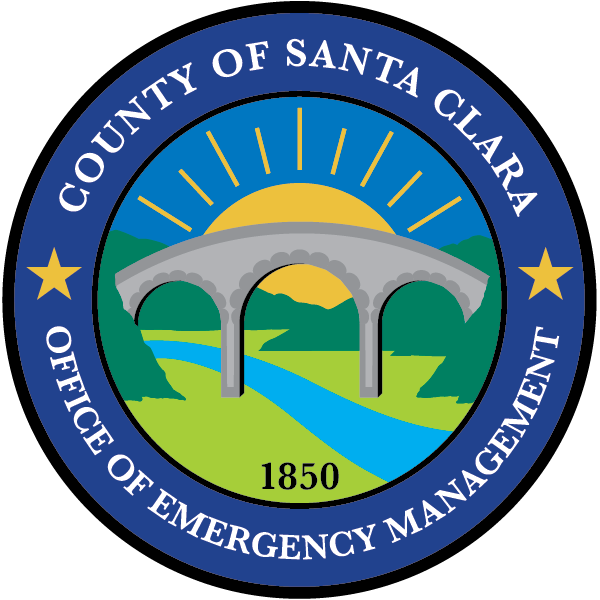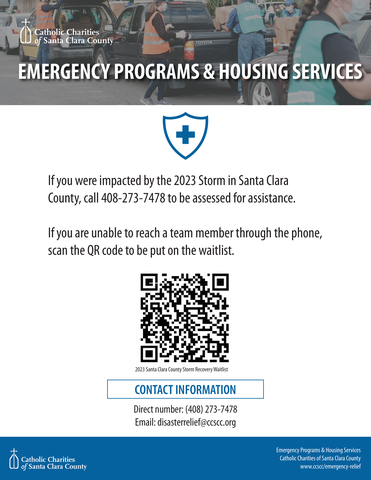RECOVERY RESOURCES
Catholic Charities’ emergency Programs and & Housing Services is offering assistance to community members impacted by the recent 2023 Winter Storms. Please call (408) 273-7478 to be assessed for assistance. If you are unable to reach a team member, please join their waitlist.
IMPORTANT WINTER STORM INFORMATION
HOTLINES
- HomeFirst Homeless Helpline (408) 539-2105 or e-mail Home First Helpline to access the City of San Jose's Overnight Warming Location (OWL) program. HomeFirst’s Outreach team provides access to emergency shelter, showers, laundry, meals, medical services, case management, employment training, and more.
- Call the County of Santa Clara, Here 4 You Call Center hotline (408) 385-2400 for assistance.
- Call 2-1-1 United Way Bay Area: for health and human services in Santa Clara County.
Please continue to monitor this page for the latest updates. If you are experiencing a medical emergency, call 9-1-1 immediately.
RESPONSE AND RECOVERY RESOURCES BY CITY
Community members may find their City's storm prep, emergency preparedness and emergency services and resources by clicking on their city below. If your city storm prep resource webpage is not listed, please email [email protected] to be included in the directory.
RESPONSE AND RECOVERY RESOURCES FOR COUNTY AND UNINCORPORATED AREAS
For shelter information, calling the County of Santa Clara, Office of Supportive Housing Here 4 You hotline at (408) 385-2400.
For information on hazardous waste removal, please contact the County of Santa Clara, Department of Environmental Health.
Office of the Assessor advises property owners about calamity relief from flood damage. Learn more on what you can do if your home becomes flooded.
Find health coverage, food assistance, financial assistance and other services at the Social Services Agency.
Visit the Consumer Protection Division website for health and safety guidelines for people returning to flooded areas.
Public Utilities
Valley Water offers free filled sandbags for residents of Santa Clara County. Grab your sandbags from one of the Sandbag Distribution Sites.
San Jose Water Company customers may find more information on on storm prep by visiting their website.
State
California Office of Emergency Services provides emergency resources and services to County's across the state during emergencies and disasters.
Listos California provides emergency preparedness resources and information in 23 languages for the different types of emergencies and disasters that could occur across the state.
Federal
As of 2/2/2023, the Major Disaster Declaration for the State of California (FEMA-4683-DR-CA) has been amended to include Santa Clara County for Public Assistance (PA). Read more on the Public Assistance program.
Santa Clara County community members may be eligible for the Economic Injury Disaster Loan. Apply today! For more information, call (800) 659-2955 or email: [email protected]. Download the fact sheet.
Get flood insurance through FEMA's National Flood Insurance Program.
Check to see if you qualify for Disaster Assistance.
Community Based Organizations and Other Partners
Collaborating Agencies Disaster Relief Effort (CADRE) is the County's official Voluntary Organization Active in Disasters. Their member organizations provide our community members with emergency support and resources.
If you have been affected by a disaster, contact the American Red Cross Silicon Valley Chapter or call 1-800-Red-Cross (1-800-733-2767) - 24 hours a day.
For the latest weather updates, please visit the National Weather Service.
If you are without power and you are a Pacific Gas and Electric customer, please visit PG&E's Power Outage.
Community members with access and functional needs can find additional support through the Disability Disaster Access & Resource Center.
WHY DO FLOODS OCCUR
Flooding is a temporary overflow of water onto land that is normally dry. Floods are the most common natural disaster in the United States. Failing to evacuate flooded areas or entering flood waters can lead to injury or death.
Floods may:
- Result from rain, snow, coastal storms, storm surges and overflows of dams and other water systems.
- Develop slowly or quickly. Flash floods can come with no warning.
- Cause outages, disrupt transportation, damage buildings and create landslides.
HOW TO PREPARE FOR FLOODS
- Sign up for AlertSCC by going to www.AlertSCC.org to receive critical information from the County when flooding is going to occur in your area. Your information is safe and you may opt-out at any time.
- Find out if you live in a flood zone. Contact Valley Water’s Community Projects Review Unit at 408-630-2650 or at [email protected], for info on basic flood information, flood insurance, zones and mapping. Don't wait! Call or email today.
- Pick up FREE filled sandbags from a Valley Water operated sandbag distribution site. There are additional sandbag sites managed by various cities within Santa Clara County. These sites are stocked with either filled sandbags or sand and empty bags for self-filling and require you to bring your own shovel. Please bring assistance for loading heavy bags, if necessary.
REPORTING CREEK FLOODING
Keep creeks clean and flowing. Trash and debris in creeks can block the flow of water and cause flooding. Help us keep creeks flowing by reporting downed trees, blockages or illegal dumping.
- Report issues in creeks to Valley Water’s Watershed Hotline: 408-630-2378
- You can also report creek issues on Access Valley Water, our online customer service portal.
REPORTING LOCAL STREET FLOOD
Yard waste, leaves, and soil can also obstruct storm drains and prevent storm water from being properly drained, causing local street flooding. To report local street flooding, please call your public works department listed below.
For more information on reporting flooding, please go to Valley Water's Report Creek Blockages and Local Flooding webpage.
| Report local street flooding | Report local street flooding | Contact local flood plain manager | |
|---|---|---|---|
| Business Hours | After Hours | Business Hours | |
| Campbell | (408) 866-2145 | (408) 866-2101 | (408) 866-2140 |
| Cupertino | (408) 777-3269 | (408) 299-2507 | (408) 777-3354 |
| Gilroy | (408) 846-0424 | (408) 846-0350 | (408) 846-0277 |
| Los Altos | (650) 947-2785 | (650) 947-2770 | (650) 947-2750 |
| Los Altos Hills | (650) 941-7222 | (408) 299-3233 | (650) 947-2511 |
| Los Gatos | (408) 399-5771 | (408) 354-8600 | (408) 399-5771 |
| Milpitas | (408) 586-2600 | (408) 586-2400 | (408) 586-3300 |
| Monte Sereno | (408) 354-7635 | (408) 354-8600 | (408) 354-7635 |
| Morgan Hill | (408) 776-7333 | (408) 779-2101 | (408) 778-6480 |
| Mountain View | (650) 903-6329 | (650) 903-6329 | (650) 903-6311 |
| Palo Alto | (650) 496-6974 | (650) 329-2413 | (650) 329-2129 |
| San Jose | (408) 794-1900 | (408) 794-1900 | (408) 535-7803 |
| Santa Clara | (408) 615-3080 | (408) 615-5640 | (408) 615-2450 |
| Saratoga | (408) 868-1245 | (408) 299-2507 | (408) 868-1232 |
| Sunnyvale | (408) 730-7400 | (408) 730-7400 | (408) 730-7444 |
| Unincorporated Area | (408) 494-2750 (East) (408) 366-3100 (West) (408) 683-1240 (South) |
(408) 299-5700 | |
| Valley Water | (408) 630-2378 | (408) 630-2650 |
Report Creek Flooding (408) 630-2378
Additional Assistance with Flood Insurance Rate Map (408) 630-2650
COUNTY ROAD CLOSURES
When flooding is occurring, County Roads and Airports Department will close county roads to keep you safe. They make every effort to provide accurate information and is not responsible for any omissions that may occur.
See the current list of road closures.
SANTA CLARA COUNTY PARK & TRAIL CLOSURES
Park and trail closures are necessary during hazardous weather conditions. For an updated list of park and trail closures, please go to Santa Clara County Parks Closures and Updates page.
To report a problem, please email [email protected]gov.org.
FLOOD SAFETY TIPS
Download the FEMA Flood Safety Sheet
Under a Flood Warning
- Find safe shelter right away.
- Do not walk, swim or drive through flood waters. Turn Around, Don’t Drown!
- Remember, just six inches of moving water can knock you down, and one foot of moving water can sweep your vehicle away.
- Stay off bridges over fast-moving water.
- Depending on the type of flooding:
- Evacuate if told to do so.
- Move to higher ground or a higher floor.
- Stay where you are.
During a Flood
- Evacuate immediately, if told to evacuate. Never drive around barricades. Local responders use them to safely direct traffic out of flooded areas.
- Contact your healthcare provider If you are sick and need medical attention. Wait for further care instructions and shelter in place, if possible. If you are experiencing a medical emergency, call 9-1-1.
- Listen to EAS, NOAA Weather Radio or local alerting systems for current emergency information and instructions regarding flooding.
- Do not walk, swim or drive through flood waters. Turn Around. Don’t Drown!
- Stay off bridges over fast-moving water. Fast-moving water can wash bridges away without warning.
- Stay inside your car if it is trapped in rapidly moving water. Get on the roof if water is rising inside the car.
- Get to the highest level if trapped in a building. Only get on the roof if necessary and once there signal for help. Do not climb into a closed attic to avoid getting trapped by rising floodwater.
- Never, ever touch a downed power line or go near one. Power lines are not insulated like power cords. Always assume the power line is live.
Staying Safe After a Flood
- Pay attention to authorities for information and instructions. Return home only when authorities say it is safe.
- Avoid driving except in emergencies.
- Wear heavy work gloves, protective clothing and boots during clean up and use appropriate face coverings or masks if cleaning mold or other debris.
- People with asthma and other lung conditions and/or immune suppression should not enter buildings with indoor water leaks or mold growth that can be seen or smelled. Children should not take part in disaster cleanup work.
- Be aware that snakes and other animals may be in your house.
- Be aware of the risk of electrocution. Do not touch electrical equipment if it is wet or if you are standing in water. Turn off the electricity to prevent electric shock if it is safe to do so.
- Avoid wading in floodwater, which can be contaminated and contain dangerous debris. Underground or downed power lines can also electrically charge the water.
- Use a generator or other gasoline-powered machinery ONLY outdoors and away from windows.
NATIONAL WEATHER SERVICE ALERT AND WARNING DEFINITIONS
Flash Flood Warning: Take Action! A Flash Flood Warning is issued when a flash flood is imminent or occurring. If you are in a flood prone area move immediately to high ground. A flash flood is a sudden violent flood that can take from minutes to hours to develop. It is even possible to experience a flash flood in areas not immediately receiving rain.
Flood Warning: Take Action! A Flood Warning is issued when the hazardous weather event is imminent or already happening. A Flood Warning is issued when flooding is imminent or occurring.
Flood Advisory: Be Aware: An Flood Advisory is issued when a specific weather event that is forecast to occur may become a nuisance. A Flood Advisory is issued when flooding is not expected to be bad enough to issue a warning. However, it may cause significant inconvenience, and if caution is not exercised, it could lead to situations that may threaten life and/or property.
Flood Watch: Be Prepared: A Flood Watch is issued when conditions are favorable for a specific hazardous weather event to occur. A Flood Watch is issued when conditions are favorable for flooding. It does not mean flooding will occur, but it is possible.

